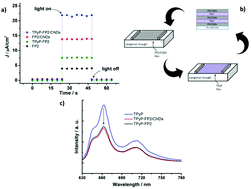Carbon nanodot-based heterostructures for improving the charge separation and the photocurrent generation†
Abstract
The possibility to employ carbon nanodots (CNDs) in solar devices was exploited by combining them with a fulleropyrrolidine derivative (FP2). The interaction between the two species was promoted by the presence of opposite electrostatic charges on CNDs (negatively charged) and FP2 (positively charged). The supramolecular dyad CNDs/FP2 generation was induced at the air/water interface of a Langmuir trough: water soluble CNDs were dissolved in the subphase and FP2 chloroform solution was spread on the subphase; the electrostatic interaction promoted the formation of the supramolecular adduct FP2/CNDs, which was then transferred onto solid substrates. Photo-induced charge transfer was promoted in the FP2/CNDs dyad and we demonstrated that the presence of CNDs increased the short-circuit current density, under light illumination, of a porphyrin–FP2/CNDs thin film by about 300% when compared with a more traditional porphyrin–FP2 solar device.



 Please wait while we load your content...
Please wait while we load your content...